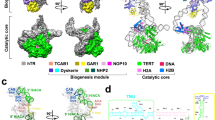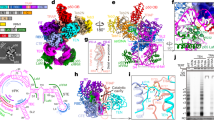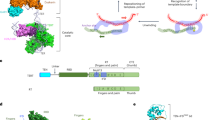Abstract
Telomerase is a large ribonucleoprotein complex minimally composed of a catalytic telomerase reverse transcriptase (TERT) and an RNA component (TR) that provides the template for telomeric DNA synthesis. However, it remains unclear how TERT and TR assemble into a functional telomerase. Here we report the crystal structure of the conserved regions 4 and 5 (CR4/5) of TR in complex with the TR-binding domain (TRBD) of TERT from the teleost fish Oryzias latipes. The structure shows that CR4/5 adopts an L-shaped three-way-junction conformation with its two arms clamping onto TRBD. Both the sequence and conformation of CR4/5 are required for the interaction. Our structural and mutational analyses suggest that the observed CR4/5-TRBD recognition is common to most eukaryotes, and CR4/5 in vertebrate TR might have a similar role in telomerase regulation as that of stem-loop IV in Tetrahymena TR.
This is a preview of subscription content, access via your institution
Access options
Subscribe to this journal
Receive 12 print issues and online access
$189.00 per year
only $15.75 per issue
Buy this article
- Purchase on Springer Link
- Instant access to full article PDF
Prices may be subject to local taxes which are calculated during checkout





Similar content being viewed by others
References
Cech, T.R. Beginning to understand the end of the chromosome. Cell 116, 273–279 (2004).
Blasco, M.A. Telomeres and human disease: ageing, cancer and beyond. Nat. Rev. Genet. 6, 611–622 (2005).
Shay, J.W. & Wright, W.E. Telomerase therapeutics for cancer: challenges and new directions. Nat. Rev. Drug Discov. 5, 577–584 (2006).
Harley, C.B. Telomerase and cancer therapeutics. Nat. Rev. Cancer 8, 167–179 (2008).
Autexier, C. & Lue, N.F. The structure and function of telomerase reverse transcriptase. Annu. Rev. Biochem. 75, 493–517 (2006).
Gillis, A.J., Schuller, A.P. & Skordalakes, E. Structure of the Tribolium castaneum telomerase catalytic subunit TERT. Nature 455, 633–637 (2008).
Mitchell, M., Gillis, A., Futahashi, M., Fujiwara, H. & Skordalakes, E. Structural basis for telomerase catalytic subunit TERT binding to RNA template and telomeric DNA. Nat. Struct. Mol. Biol. 17, 513–518 (2010).
Chen, J.L., Blasco, M.A. & Greider, C.W. Secondary structure of vertebrate telomerase RNA. Cell 100, 503–514 (2000).
Chen, J.L. & Greider, C.W. Telomerase RNA structure and function: implications for dyskeratosis congenita. Trends Biochem. Sci. 29, 183–192 (2004).
Mitchell, J.R. & Collins, K. Human telomerase activation requires two independent interactions between telomerase RNA and telomerase reverse transcriptase. Mol. Cell 6, 361–371 (2000).
Mitchell, J.R., Cheng, J. & Collins, K. A box H/ACA small nucleolar RNA-like domain at the human telomerase RNA 3′ end. Mol. Cell. Biol. 19, 567–576 (1999).
Tesmer, V.M. et al. Two inactive fragments of the integral RNA cooperate to assemble active telomerase with the human protein catalytic subunit (hTERT) in vitro. Mol. Cell. Biol. 19, 6207–6216 (1999).
Vulliamy, T. et al. The RNA component of telomerase is mutated in autosomal dominant dyskeratosis congenita. Nature 413, 432–435 (2001).
Vulliamy, T., Marrone, A., Dokal, I. & Mason, P.J. Association between aplastic anaemia and mutations in telomerase RNA. Lancet 359, 2168–2170 (2002).
Robart, A.R. & Collins, K. Human telomerase domain interactions capture DNA for TEN domain-dependent processive elongation. Mol. Cell 42, 308–318 (2011).
Chen, J.L., Opperman, K.K. & Greider, C.W. A critical stem-loop structure in the CR4–CR5 domain of mammalian telomerase RNA. Nucleic Acids Res. 30, 592–597 (2002).
Brown, Y. et al. A critical three-way junction is conserved in budding yeast and vertebrate telomerase RNAs. Nucleic Acids Res. 35, 6280–6289 (2007).
Mason, D.X., Goneska, E. & Greider, C.W. Stem-loop IV of tetrahymena telomerase RNA stimulates processivity in trans. Mol. Cell. Biol. 23, 5606–5613 (2003).
Richards, R.J. et al. Structural study of elements of Tetrahymena telomerase RNA stem-loop IV domain important for function. RNA 12, 1475–1485 (2006).
Bley, C.J. et al. RNA-protein binding interface in the telomerase ribonucleoprotein. Proc. Natl. Acad. Sci. USA 108, 20333–20338 (2011).
Harkisheimer, M., Mason, M., Shuvaeva, E. & Skordalakes, E. A motif in the vertebrate telomerase N-terminal linker of TERT contributes to RNA binding and telomerase activity and processivity. Structure 21, 1870–1878 (2013).
Kim, N.K., Theimer, C.A., Mitchell, J.R., Collins, K. & Feigon, J. Effect of pseudouridylation on the structure and activity of the catalytically essential P6.1 hairpin in human telomerase RNA. Nucleic Acids Res. 38, 6746–6756 (2010).
Leeper, T., Leulliot, N. & Varani, G. The solution structure of an essential stem-loop of human telomerase RNA. Nucleic Acids Res. 31, 2614–2621 (2003).
Kim, N.K., Zhang, Q. & Feigon, J. Structure and sequence elements of the CR4/5 domain of medaka telomerase RNA important for telomerase function. Nucleic Acids Res. 42, 3395–3408 (2013).
Xie, M. et al. Structure and function of the smallest vertebrate telomerase RNA from teleost fish. J. Biol. Chem. 283, 2049–2059 (2008).
Podlevsky, J.D., Bley, C.J., Omana, R.V., Qi, X. & Chen, J.J. The telomerase database. Nucleic Acids Res. 36, D339–D343 (2008).
Jiang, J. et al. The architecture of Tetrahymena telomerase holoenzyme. Nature 496, 187–192 (2013).
Zhang, Q., Kim, N.K., Peterson, R.D., Wang, Z. & Feigon, J. Structurally conserved five nucleotide bulge determines the overall topology of the core domain of human telomerase RNA. Proc. Natl. Acad. Sci. USA 107, 18761–18768 (2010).
Cash, D.D. et al. Pyrimidine motif triple helix in the Kluyveromyces lactis telomerase RNA pseudoknot is essential for function in vivo. Proc. Natl. Acad. Sci. USA 110, 10970–10975 (2013).
Theimer, C.A., Blois, C.A. & Feigon, J. Structure of the human telomerase RNA pseudoknot reveals conserved tertiary interactions essential for function. Mol. Cell 17, 671–682 (2005).
Qiao, F. & Cech, T.R. Triple-helix structure in telomerase RNA contributes to catalysis. Nat. Struct. Mol. Biol. 15, 634–640 (2008).
Qiao, F., Goodrich, K.J. & Cech, T.R. Engineering cis-telomerase RNAs that add telomeric repeats to themselves. Proc. Natl. Acad. Sci. USA 107, 4914–4918 (2010).
Otwinowski, Z. & Minor, W. Processing of X-ray diffraction data collected in oscillation mode. Methods Enzymol. 276, 307–326 (1997).
De La Fortelle, E. & Bricogne, G. Maximum-likelihood heavy-atom parameter refinement for multiple isomorphous replacement and multiwavelength anomalous diffraction methods. Methods Enzymol. 276, 472–494 (1997).
Emsley, P., Lohkamp, B., Scott, W.G. & Cowtan, K. Features and development of Coot. Acta Crystallogr. D Biol. Crystallogr. 66, 486–501 (2010).
Adams, P.D. et al. PHENIX: a comprehensive Python-based system for macromolecular structure solution. Acta Crystallogr. D Biol. Crystallogr. 66, 213–221 (2010).
McCoy, A.J. et al. Phaser crystallographic software. J. Appl. Crystallogr. 40, 658–674 (2007).
Qi, X. et al. The common ancestral core of vertebrate and fungal telomerase RNAs. Nucleic Acids Res. 41, 450–462 (2013).
Acknowledgements
We thank Y. Li (University of Michigan) and K. Wan (University of Michigan) for technical support and F. Guo (University of California, Los Angeles) for suggestions. M.L. is supported as a Howard Hughes Medical Institute Early Career Scientist. This work was supported by grants from the Ministry of Science and Technology of China (2013CB910400 to M.L.), the Strategic Priority Research Program of the Chinese Academy of Sciences (XDB08010201 to M.L.) and the US National Institutes of Health (RO1GM094450 to J.J.-L.C.).
Author information
Authors and Affiliations
Contributions
J.H. carried out the bulk of the experiments; C.J.B. and D.P.R. established constructs and protocols for expression and purification of the soluble telomerase monomeric protein–RNA core complex; A.F.B. performed the telomerase assays; J.W., L.W. and R.Z. determined the CR4/5–TRBD structure; J.X. purified the S. pombe TRBD protein; J.J.-L.C. and M.L. designed the project and wrote the paper.
Corresponding authors
Ethics declarations
Competing interests
The authors declare no competing financial interests.
Integrated supplementary information
Supplementary Figure 1 Structure of the TRBD–CR4/5 complex.
(a) ITC measurement of the interaction between medaka TRBD (residues 318-579) and CR4/5 (nt 170-220). (b) Electron density map of the TRBD-CR4/5 interface. 2Fo-Fc map of the CR4/5 nucleotides (orange) and the TRBD residues (blue) at the TRBD-CR4/5 interface are contoured at 1.5 σ, related to Fig. 3c,d,f and Supplementary Fig. 3b,c. (c) Superposition of the two sets of TRBD-CR4/5 molecules in the asymmetric unit. The helices α4 and α9 in the molecules A have an altered orientation due to crystal packing. (d) Structural superposition of the Oryzias latipes (medaka) TRBD-CR4/5 complex (blue) with the Takifugu rubripes (fugu) TRBD domain (orange, PDB accession code 4LMO1).
Supplementary Figure 2 Sequence alignments of the TRBD domain of TERT and the CR4/5 (TWJ) domain of TR.
(a) Primary sequence alignment of the TRBD domain of TERT. Conserved motifs of TRBD are boxed. Secondary structure assignments are shown as cylinders (α helices) and arrows (β strands) and are colored blue. Ol_Tert, Oryzias latipes; Dr_Tert, Danio rerio; Hs_Tert, Homo sapiens; Mm_Tert, Mus musculus; Xl_Tert, Xenopus laevis; Tc_Tert, Tribolium castaneum; Tt_Tert, Tetrahymena thermophila; Sp_Tert, Schizosaccharomyces pombe. (b) Sequence alignment of the vertebrate CR4/5 domains and the fungi TWJ domains, based on predicted secondary structures. Conserved RNA secondary structures are denoted. The conserved nucleotide A at the junction J6/J6.1 as well as its interacting nucleotide G are highlighted in orange.
Supplementary Figure 3 Structural and mutational analyses of the TRBD-CR4/5 interaction.
(a) Structural superposition of the crystal structure of medaka P6.1 (orange) with the NMR structures of human P6.1 (cyan, PDB accession code 1OQ02) and pseudouridylated human P6.1 (magenta, PDB accession code 2KYE3). (b) Stereo view of the stem P6-mediated TRBD-CR4/5 interactions. The intermolecular hydrogen bonds are shown as dashed magenta lines. (c) Stereo view of the stem P6.1-mediated TRBD-CR4/5 interactions. (d) ITC measurements of the interactions between wild-type and mutant TRBD and CR4/5, related to Table 2. ol_TRBD, Oryzias latipes TRBD; sp_TWJ, Schizosaccharomyces pombe three-way junction.
Supplementary Figure 4 Analyses of the TRBD-CR4/5 and TRBD-TWJ interactions.
(a) Superposition of the TRBD-CR4/5 complex structure with the NMR structure of the medaka CR4/5 based on stem P6 (left panel) and stem P6.1 (right panel), respectively. TRBD is colored blue and the CR4/5 free and in the complex is colored cyan and orange, respectively. In the structure of the free CR4/5, the TRBD-binding nucleotides on stem P6 and stem P6.1 are colored magenta and yellow, respectively. The black box denotes the spatial collision happens between TRBD and stem P5 in the structural superposition based on stem P6.1. (b) ITC measurements of the interactions between wild-type and the A1060 mutants of S. pombe TWJ and TRBD, related to Table 3. The TWJ_A1060G mutant RNA was not correctly folded, as shown in its gel filtration profile compared with that of the wild-type TWJ RNA. (c) Telomerase primer-extension assays of wild type and mutant S. pombe and N. crassa telomerases, related to Fig. 4c. (d) Fugu CR4/5 can bind to medaka TRBD efficiently, as shown in the HiLoad 200 gel filtration profile.
Supplementary Figure 5 Implication of the TRBD–CR4/5 structure on the architecture of vertebrate telomerase.
(a) Comparison of the structural organizations between the distal SL4 region of ciliate telomerase RNA (left panel) and the stem P6.1 of vertebrate CR4/5 (right panel). The organization of SL4 in Tetrahymena telomerase is adapted from Fig. 2g in Ref. 27 of the main text. In both structures, TRBD is shown as electrostatic potential surface. The medaka CR4/5-TRBD structure is oriented in the same direction as that of the Tetrahymena TRBD. (b) A proposed architecture of vertebrate telomerase based on the CR4/5-TRBD crystal structure, shown in two perpendicular views. The color theme and the figure denotation are the same as that of Fig. 1a in the main text.
Supplementary information
Supplementary Text and Figures
Supplementary Figures 1–5 (PDF 988 kb)
Rights and permissions
About this article
Cite this article
Huang, J., Brown, A., Wu, J. et al. Structural basis for protein-RNA recognition in telomerase. Nat Struct Mol Biol 21, 507–512 (2014). https://doi.org/10.1038/nsmb.2819
Received:
Accepted:
Published:
Issue Date:
DOI: https://doi.org/10.1038/nsmb.2819
This article is cited by
-
Structure of active human telomerase with telomere shelterin protein TPP1
Nature (2022)
-
LARP7-like protein Pof8 regulates telomerase assembly and poly(A)+TERRA expression in fission yeast
Nature Communications (2018)
-
Globular domain structure and function of restriction-like-endonuclease LINEs: similarities to eukaryotic splicing factor Prp8
Mobile DNA (2017)
-
Structural basis of template-boundary definition in Tetrahymena telomerase
Nature Structural & Molecular Biology (2015)
-
Protein-RNA interaction restricts telomerase from running through the stop sign
Nature Structural & Molecular Biology (2015)



